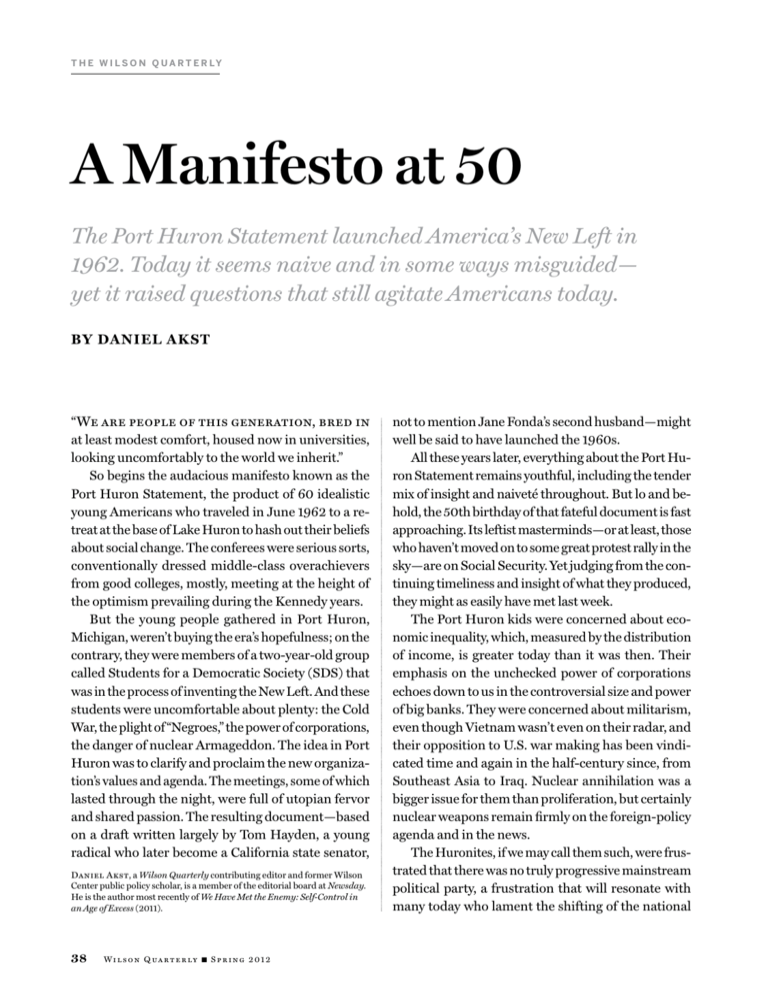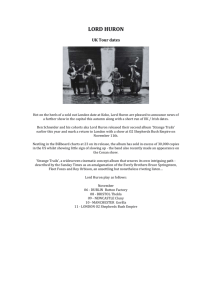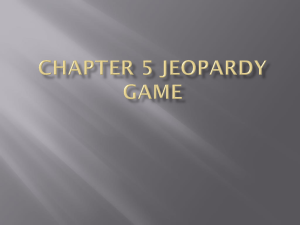PDF - Wilson Quarterly
advertisement

T h e W i l s o n Q u a r t e r ly A Manifesto at 50 The Port Huron Statement launched America’s New Left in 1962. Today it seems naive and in some ways misguided— yet it raised questions that still agitate Americans today. By DANIEL AKST “We are people of this generation, bred in at least modest comfort, housed now in universities, looking uncomfortably to the world we inherit.” So begins the audacious manifesto known as the Port Huron Statement, the product of 60 idealistic young Americans who traveled in June 1962 to a retreat at the base of Lake Huron to hash out their beliefs about social change. The conferees were serious sorts, conventionally dressed middle-class overachievers from good colleges, mostly, meeting at the height of the optimism prevailing during the Kennedy years. But the young people gathered in Port Huron, Michigan, weren’t buying the era’s hopefulness; on the contrary, they were members of a two-year-old group called Students for a Democratic Society (SDS) that was in the process of inventing the New Left. And these students were uncomfortable about plenty: the Cold War, the plight of “Negroes,” the power of corporations, the danger of nuclear Armageddon. The idea in Port Huron was to clarify and proclaim the new organization’s values and agenda. The meetings, some of which lasted through the night, were full of utopian fervor and shared passion. The resulting document—based on a draft written largely by Tom Hayden, a young radical who later become a California state senator, Daniel Akst, a Wilson Quarterly contributing editor and former Wilson Center public policy scholar, is a member of the editorial board at Newsday. He is the author most recently of We Have Met the Enemy: Self-Control in an Age of Excess (2011). 38 Wi l s o n Q u a r t e r l y n S p r i n g 2 0 1 2 not to mention Jane Fonda’s second husband—might well be said to have launched the 1960s. All these years later, everything about the Port Huron Statement remains youthful, including the tender mix of insight and naiveté throughout. But lo and behold, the 50th birthday of that fateful document is fast approaching. Its leftist masterminds—or at least, those who haven’t moved on to some great protest rally in the sky—are on Social Security. Yet judging from the continuing timeliness and insight of what they produced, they might as easily have met last week. The Port Huron kids were concerned about economic inequality, which, measured by the distribution of income, is greater today than it was then. Their emphasis on the unchecked power of corporations echoes down to us in the controversial size and power of big banks. They were concerned about militarism, even though Vietnam wasn’t even on their radar, and their opposition to U.S. war making has been vindicated time and again in the half-century since, from Southeast Asia to Iraq. Nuclear annihilation was a bigger issue for them than proliferation, but certainly nuclear weapons remain firmly on the foreign-policy agenda and in the news. The Huronites, if we may call them such, were frustrated that there was no truly progressive mainstream political party, a frustration that will resonate with many today who lament the shifting of the national policy conversation to the right. Partly to blame, in their view, was the parties’ lack of ideological purity—each contained liberals and conservatives. They saw this “party overlap” as a “structural antagonist of democracy,” complaining that it led to “organized political stalemate.” They had just the remedy, too: Drive most southern Democrats, who so often lined up with Republicans, out of the Democratic Party. If only one could shout back across time about the importance of being careful what you wish for. As it turns out, the southerners left the party after it enacted the great civil rights legislation of the 1960s. Now we have more ideologically consistent parties—along with more stalemate, not less. That’s an especially bitter irony given Port Huron’s focus on broadening democracy. Above all else, the Huronites were determined that Americans should gain control of their own destiny through a democratic process that would supersede the power of government bureaucrats and corporations alike. Their own fervent deliberations embodied the group’s obsession with participatory democracy, which was inspired by the philosopher Arnold Kaufman, a teacher of Hayden’s at the University of Michigan. In keeping with their faith in what might be called radical democracy, the young SDS members believed the very best about people—“we regard men as infinitely precious and possessed of unfulfilled capacities for reason, freedom, and love”—and were desperate to turn back the tide of alienation they felt was engulfing Americans. “Loneliness, estrangement, isolation describe the vast distance between man and man today. These dominant tendencies cannot be overcome by better personnel management, nor by improved gadgets, but only when a love of man overcomes the idolatrous worship of things by man.” group Courtesy C. Clark Kissinger, Pages Courtesy Helen Garvy Leaders of the Students for a Democratic Society gathered in Bloomington, Indiana, a year after issuing the Port Huron Statement. Tom Hayden (left), the document’s chief author, later became a well-known California activist and politician. A Manifesto at 50 Those same words might have been written yesterday, and not just by some young radicals. On the contrary, they could as easily have come from evangelical Christians, academic communitarians, secular social critics (such as Jaron Lanier, author of the 2010 manifesto You Are Not a Gadget), or almost anyone recoiling from the radical individualism that many people feel has beset our vast and fast-moving society. Pretty much the only ones who couldn’t have penned those words, if you’ll forgive an anachronistic metaphor, are modern feminists, who would bristle at the use of “man” to stand in for the half of us who are female. In fact, for all its prescience and progressiveness, the single most striking thing about the Port Huron statement from today’s perspective is that it’s oblivious to women’s issues, even though some of the conferees were women. The Port Huron Statement otherwise is a thoroughgoing expression of a certain worldview—an outlook present on one side in the political and culture wars that have sharply divided the country in recent years and brought Washington practically to a standstill. What most people don’t realize is that there was another important statement crafted by a conference of young idealists back in those days, one that encapsulates a very different worldview just as effectively as Port Huron embodies the progressive one. And while the founding document of the SDS is the far more famous of the two, the other is surely as significant. Each of these sharply contrasting texts can shed useful light on the other, and read together, they provide a crisply binocular view of the American body politic today. Idealistic manifestoes and declarations, it should be noted, have always been important in American history. The Mayflower Compact proclaimed our specialness, and our special obligation to God. The Declaration of Independence and the Constitution launched a new country based on a set of bold principles. In the post–World War II era, Barry Goldwater’s passionate acceptance of the GOP presidential nomination in 1964 (“extremism in the defense of liberty is no vice”), John F. Kennedy’s stirring inaugural vow to “pay any price, bear any burden,” and Martin Luther King Jr.’s inspiring “I have a dream” speech all galvanized the nation and changed the course of its history. While the counterculture, the civil rights movement, opposition to the Vietnam War, and student 40 Wi l s o n Q u a r t e r l y n S p r i n g 2 0 1 2 radicalism define the 1960s for many Americans, in recent years scholars have demonstrated that there was more to the era’s politics than leftist agitation. “The untold story of the 1960s is about the New Right,” sociologist Rebecca E. Klatch insists in A Generation Divided: The New Left, the New Right, and the 1960s (1999), a book that depicts the decade “as a time of ferment for the Right as well as the Left. Idealistic youth from one end of the political spectrum to the other formed movements to reshape American politics.” In September 1960, just a few months after the very first meeting of SDS and nearly two years before the Port Huron conference, more than 100 young conservatives from 44 colleges and universities descended on the estate of conservative author and editor William F. Buckley Jr., in Sharon, Connecticut. The meeting was inspired by a suggestion from Senator Barry Goldwater, the up-and-coming Arizona Republican who was helping transform the GOP, that America’s youthful conservatives set up a national organization. Goldwater, don’t forget, was a ruggedly handsome and outdoorsy former fighter pilot who, for a while at least, was a magnet for young activists—including Joan Didion and Hillary Rodham. The Sharon conference was almost a mirror image of the one that would come later at Port Huron. At both events, excitement was in the air. Idealistic young Americans gathered to reshape the future and reveled in being among like-minded people. While the SDS folks would retreat to a United Auto Workers camp to formulate their manifesto, the conservatives in Sharon brought forth not just a statement, but an organization—Young Americans for Freedom (YAF)—at Great Elm, the Buckley family’s 47-acre country seat, where parts of the vast main house dated back to 1763. The Sharon Statement, at least at first glance, seems to be everything its counterpart on the left was not. Drafted by M. Stanton Evans, a young Indianapolis newspaperman, the one-page document is a model of brevity and coherence, especially compared with the rambling 64-page Port Huron Statement. That length wasn’t just a matter of leftist logorrhea; Hayden, who reportedly had read the Sharon Statement, was himself a newspaperman of sorts, serving as editor of the University of Michigan’s student daily. The great economy of the Sharon Statement simply reflected its A Manifesto at 50 view of human nature and their desire to transform the entire world by simultaneously enlisting government while protecting people from it, produced a wildly utopian manifesto whose length speaks volumes about its contradictions and overreach. Yet on closer inspection, the Sharon Statement was perhaps no less utopian. Its tightly ordered vision of free people and free markets, with the role of government limited to protecting individual freedom “through the preservation of internal order, the provision of national defense, and the administration of justice,” narrows the public sphere almost to the vanishing point. Taxes, to the Sharon conferees, sounded not just like theft, but poison, at least when used for anything other than personal and national security: When government “takes from one man to bestow on another, it diminishes the incentive of the first, the integrity of the second, and the moral autonomy of both.” In the Sharon worldview, this made sense, for “when government interferes with the work of the market economy, it tends to reduce the moral and physical strength of the nation.” Even liberals will acknowledge that government meddling in commerce—Fannie Mae, anyone?—can make a mess of things, and the clarity of the Sharon vision is seductive. Yet surely schools play some role in the moral and physical strength of the nation, to say nothing of decently supported retirees or decently paved roads. The differences between the Sharon and Port Huron manifestoes seem stark. The Sharon drafters might be said, in Isaiah Berlin’s famous formulation of 1958, to be concerned with negative freedom, or protecting the rights of individuals from external constraint, while the students at Port Huron focused more on positive freedom, or the ability to meet one’s needs and achieve one’s potential. Freedom to go to the supermarket counts for little, after all, if one lacks the money to buy food. The SDS adherents, perceptively, also saw freedom as embedded in community, recognizing that a society of self-interested pinballs bouncing off one another and their surroundings probably isn’t sustainable. Similarly, the Sharonites seemed not to worry at all about the accumulation of private power, focusing instead on the threat from government, while the Huronites were somehow both fearful of government Getty Images In 1970, William F. Buckley (with clipboard) celebrated the 10th anniversary of the Sharon Statement at his Connecticut estate. much clearer message: the less government, the better. The basic idea was to let people take care of themselves, a viewpoint not very difficult to elaborate then or now. The Port Huron Statement is so much longer because its many earnest drafters had a much heavier lift. They were determined not only to perfect relations among “men” but to safeguard against the undue power government and business tend to arrogate to themselves—even as they demanded that the same inept and militaristic state they reviled somehow manage housing, capital allocation, and other things by now demonstrably beyond its competence. Since they shared with their Sharon counterparts a profound distrust of government, it’s fair to ask how they can have hoped to harness the unruly leviathan on behalf of the public good and the popular will. The answer? “By steadfast opposition to bureaucratic coagulation, and to definitions of human needs according to problems easiest for computers to solve. Second, the bureaucratic pileups must be at least minimized by local, regional, and national economic planning—responding to the interconnection of public problems by comprehensive programs of solution. Third, and most important, by experiments in decentralization.” The Port Huron conferees, with their starry-eyed Wi l s o n Q u a r t e r l y n Wi n t e r 2 0 1 2 41 A Manifesto at 50 and in love with the potential of collective action. At the same time, they were all too conscious of the great weight of private (read: corporate) power. I say “too conscious” because they were sorely handicapped by the Left’s traditional fear, loathing, and sheer misunderstanding of the private sector, which—let’s face it—is the source of most of the wealth and innovation that make improvement in the world possible. Yet the two statements—and many of their middleclass drafters—had a great deal in common, including a deep faith in the American people and their ability to govern themselves. At the same time, the drafters and their manifestoes were disillusioned with the cautiously liberal consensus that had prevailed during their young lives, and impatient with the pragmatism and compromise embodied by the Kennedy administration. They believed in pushing governance further down the democratic pyramid, and were suspicious of far-off technocrats and others who might exercise power over people. If the two statements were cast as a Venn diagram, their considerable overlap could be labeled libertarianism. Implicit in both is a kind of nostalgia: for a smaller, simpler polity than the United States had become, and for direct relations among people rather than between individuals and huge centers of undemocratic power. Most of all, the framers of both statements believed in political action as a way to advance what was essentially a moral agenda. It’s not difficult to see the roots of our current impasse in these two ambitious documents. The emphasis on individual rights (Sharon) or participatory democracy (Port Huron), carried to extremes, leads to the kind of paralysis the commentator Jonathan Rauch has termed “demosclerosis,” in which it’s all too easy for determined stakeholders to protect special privileges or block needed public improvements, such as a subway extension or overhaul of the power grid, at great cost to everyone else. The emphasis on rights over responsibilities in both statements—how different from President Kennedy’s demand back then to “ask not what your country can do for you”!—may have helped justify the selfishness and narcissism of succeeding decades. And the uncompromising idealism of both statements probably contributed to the later breakdown of cooperation across the aisle in Washington. SDS grew increasingly radical as the 42 Wi l s o n Q u a r t e r l y n S p r i n g 2 0 1 2 1960s wore on, and in 1969 its most revolutionary elements broke away, some of them eventually helping to form the violent Weather Underground, whose bombings and anti-Americanism helped alienate the very working-class voters the Weathermen’s erstwhile associates had hoped to enlist in combating capitalism. While SDS was defunct by the mid-1970s, YAF persists to this day, and the conservative movement it continues to support has scooped up those same alienated white working-class voters. Those are the voters who propelled Ronald Reagan into the White House, and whose defection has made life so difficult for the Democratic Party ever since. Now that even the most basic government initiatives are contested, the top marginal tax rate has been slashed, and unions in the private sector have all but vanished, it’s easy to dismiss the Port Huron Statement as idealistic raving. The Sharon Statement, it would seem, has won the day. But assuming so would be a big mistake. All the important progressive changes of the last couple of centuries—abolitionism, women’s suffrage, civil rights for blacks and, later, gays—have bubbled up through social movements like those framed by the words written in Michigan 50 years ago. The massive antiwar campaign SDS would soon enough help foment was a prime example. The historical fact is that half a century after Port Huron, hardly any advanced societies in the world look anything like the one idealized by the young conservatives who met in Sharon. What’s nearly universal instead is a never-ending effort to balance the rights of individuals with the needs that, in the modern world, it seems only government can meet. If the Port Huron Statement was absurd to suppose that collective action can solve all the world’s problems, surely it was just as silly for the Sharon Statement to suggest that collective action can’t solve any of them, even the ones right here under our collective noses. The challenge for us today, 50 years after Port Huron, is to embrace what was best about the SDS statement—its warnings against militarism, its emphasis on citizen involvement, and its insistence on equality—while bearing in mind that other statement, so that we can come to some agreement on the proper role of government in a bigger, more complex, and more interconnected world than the framers of either document ever imagined. n

![PW Heavy Equipment Operator [Read More]](http://s3.studylib.net/store/data/006999445_1-8417856b741c62f00336b7e979d86f7e-300x300.png)




